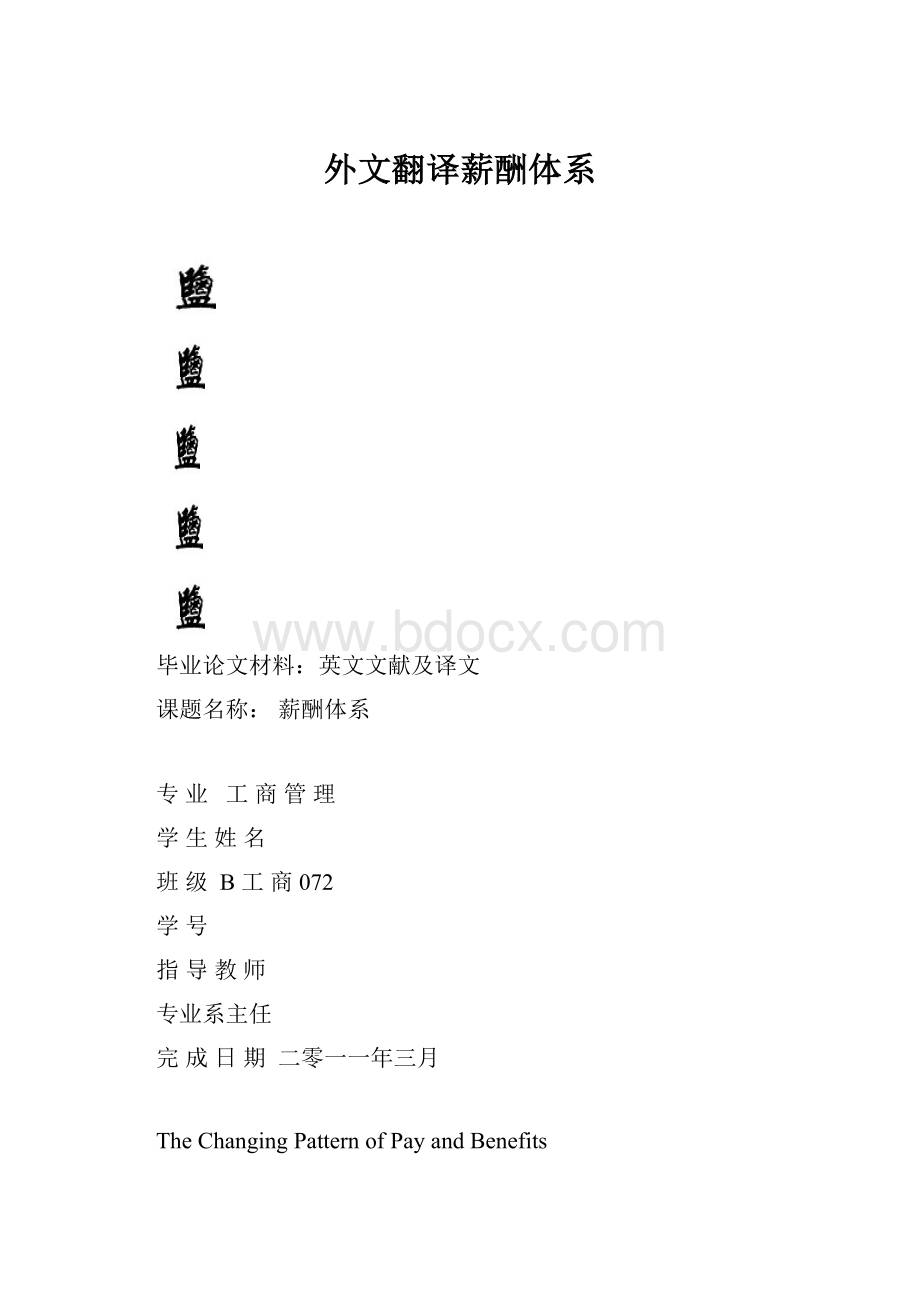外文翻译薪酬体系.docx
《外文翻译薪酬体系.docx》由会员分享,可在线阅读,更多相关《外文翻译薪酬体系.docx(17页珍藏版)》请在冰豆网上搜索。

外文翻译薪酬体系
毕业论文材料:
英文文献及译文
课题名称:
薪酬体系
专业工商管理
学生姓名
班级B工商072
学号
指导教师
专业系主任
完成日期二零一一年三月
TheChangingPatternofPayandBenefits
Tudor,ThomasR,Trumble,RobertR
JournalofCompensation&Benefits/May/2008
Today,manycompaniesstillbasetheirrewardsystemsonthe1950scompensationmodelmadepopularduringthebriefperiodwhenU.S.companiesdominatedtheworld.Withtodaysincreasinglycompetitiveenvironment,however,companiesmustlookmorecloselyatthecost-benefitofrewards,insteadofjustusingtheminanattempttoreduceemployeedissatisfaction.Companiesmustprovideshort-termmotivationandencourageemployeestodeveloplong-termskillsthatwillaidthecompany.Mostimportantly,companiesmustalsoattractandretainhighperformers,insteadofalienatingthemwithpaysystemsthatgiveeveryonepayincreaseswithoutregardtolevelsofperformance.Forexample,suchnewcompensationapproachesmayincludeskill-basedpay,gainsharingplans,andflexiblebenefitssystems.
Traditionalcompensationapproachesarestilloftenmodeledonthecentralization-basedorganizationalmodel,inwhichdecisionsweremadeatthetopandmanagementrigidlydefinedtasks.However,withglobalcompetitionbecominganincreasinglyprominentissue,companiesneedrewardsystemsthatmatchtheirmovementtodecentralizedstructures.Largernumbersofcompaniesarealsobecomingveryawarethattheycannotjustpassadditionalcompensationcostsontofuturecustomers.Today,ourpaysystemsmustmoveinstepwiththeparticipative-managementtrendbybecomingmoreflexibleinsteadofremainingfixed.Thisadjustmentinvolvesmanyfactorsincludingshorterproductlifecycles,aneedtobemoreflexible,aneedforworkerstocontinuallygainadditionalskills,andforthemtothinkmoreonthejob.
Intoday'smostsuccessfulcompanies,employeerewardsandbenefitsareincreasinglyincorporatedintoanorganization'sstrategicplanning.Why?
Therationaleisthatemployeecompensationhasasubstantialimpactonthelong-termfinancialpositionofafirm.Compensationstructuresshouldconsideranorganization'sstrategicrequirementsandshouldmatchorganizationalgoals.Compensationstrategicplanningshouldinvolve:
considerationoftheinternalandexternalenvironment;andcreationofanorganization'scompensationstatement,compensationgoals,andthedevelopmentofcompensationpolicies.
Today,onestrategiccompensationtrendistheuseofpayincentivesinsteadofthetraditional,annual“everybodygets”payincrease.Therationaleistocontrolcostsandtomorecloselytieperformancetocompensation.Wecangroupthechangingpatternofcompensationintotwogeneralareas:
PayMethodTrendsandBenefitsTrends.HumanResourcesmanagersshouldfamiliarizethemselveswiththesechangingtrendsanddeterminetheplanthatismostsuitablefortheirorganization.
PAYMETHODTRENDS
Thereareanumberofpaymethodsavailableforusebyemployers,includinggeneralpayincreases,cost-of-livingincreases,meritpay,bonuses,skill-basedpay,competence-basedpay,CEOcompensation,gainsharing,andvarioustypesofincentivepay.
GeneralPayIncrease
Ageneralpayincreaseisapayincreasegiventoeveryoneinacompany.Itcanbealump-sumpayment,butitismorelikelytobeapercentageincreaseinbasesalary.Theemployer'srationaleforthepayincreasemayhavebeentheresultofamarketsurvey,jobevaluation,orjustaprofitableyear.Thetrend,however,isforgeneralincreasestodeclineaspay-for-performancesystemsbecomeincreasinglydominant.Inaddition,givingeveryonethesameraisesometimesdecreasesmoralebecausehigh-performingemployeesseepoorperformersgettingthesamereward.
Cost-of-LivingIncrease
Cost-of-livingincreasesaregeneralpayincreasestriggeredbyariseinaninflation-sensitiveindex,suchastheconsumerpriceindexortheproducerpriceindex.Aswithgeneralpayincreases,theuseofcost-of-livingpayincreasesisdecreasingamongcompanies.Therationaleforthisdecreaseisthatwithlowerinflation(thuslittlechangeinprices),incomesaremorestableandtheneedforinflationadjustmentsisnotasgreatasitwasinthepast.Inaddition,collectivebargainingagreementsarenowlesslikelytoincludeprovisionsforcost-of-livingincreases,sononunionfirmsarenotunderasmuchpressuretoprovidetheminanattempttomatchunion-negotiatedcompensation.Theirdeclinecanalsobeattributedtothefactthatemployersaremovingawayfrompaysystemsthatarenonperformancerelated.
MeritPay
Meritpayisanothergenericterminwhichpayincentivesaregivenforoveralljobperformance.²Someproblemsfrequentlyencounteredwithmeritpayplansinclude:
∙theuseofsubjectivecriteriawhenmeasuringemployeeperformance;
∙alackofuniformstandardsforratingindividualemployees;
∙differencesamongmanagersinhowtomakeindividualratings.
Meritpaywasthefirstattemptbyfirmstocreateapay-for-performancesystem.However,duetoemployer(andemployee)dissatisfactionwithmeritpayplans,thetrendistoeliminatethemandinsteadusepay-for-performanceplansthataremoreobjective(suchasbonusplans),andthatusespecificperformancemeasuringcriteriathataidintheperformanceappraisalprocess.³Thistrendincludesboththeprivateandpublicsectors,becausethemeritpaysysteminthefederalsectorhasalsobeeninadequate.
Bonus
Abonusisagenericterminvolvingatypeofpay-for-performanceplan.Managerscangiveabonusforindividualorgroupperformance,andformeetingobjectivessuchasMBO(managementbyobjectives).Researchersandpractitionershavegiventheseplanshighmarksformotivatingemployees,forcreatingloyalty,andformeetingperformanceobjectives.Inaddition,bonusesreducetheturnoverofhigh-performingemployeesandincreasetheturnoveroflowperformers,whodonotgetbonuses.Ifthebonussystemiswell-designed,theyalsocreateinternalequity.Assuch,bonussystems(pay-for-performance)arethecurrenttrendincompensation.
Skill-BasedPay
Skill-basedpayemphasizesacompany'sdesiretoincreasetheskillsandknowledgeofitsworkforce.Itmayinvolveclasses,voluntaryjobrotation,ortests.Itsbenefitsaremany,includinghavingtrainedpeopleavailabletodoajobifsomeoneisabsent.Skill-basedpayalsoworkswellwithqualitycirclesbecause:
∙itprovidesemployeeswithabetterunderstandingofthejobstheircoworkersperform;
∙itreducesresistancetorestructuringorotherneededchanges;
∙itleadstoamoreflexible
workforcethatcanbetteradapttonewtechnologiesorprocesses;anditencouragesalearningenvironment.Itdoes,however,requirealargeinvestmentintrainingwhichcanbeexpensive.
Competence-BasedPay
Competence-basedpay(thegridsystem)isverynewanddoesvaryfromplan-to-plan.Theideaisnotonlytorewardemployeesforhowwelltheydoajob,butforhowtheydothejob.Forexample,acompetence-basedpayplancanbeusedtopersuadeworkerstousethecomputersthataresittingontheirdesks,ortoadapttootherchangesthatcomealong.Therationalebehindacompetence-basedpayplanistokeepemployeeskillscurrent.
CEOCompensation
ThecompensationofCEOs(andothertopexecutives)hasalsobeenchanging,andnowincludesmorepayincentives—suchasstockoptions—tobetterlinkperformancewithcompensation.Planslinkingexecutivepaywithperformancemayincludestockoptions,cashbonuses,phantomstock,ordeferredcompensation,allofwhicharewaysofmakingtopmanagementmoreaccountableforcompanyperformance.Today,performanceconsiderationsarealargerpartofexecutivecompensation.TheSecuritiesandExchangeCommissionalsorequirescorporationstoexplaintherationalebehindtheirexecutivecompensationprogramstoshareholders.
Gainsharing
Gainsharingisapay-for-performanceplaninwhich“gains”aresharedwithemployeesforimprovementsinprofitabilityorproductivity.Gainsharingplansaredesignedtocreateapartnershipwithemployeessothatbothmanagementandlaborareworkingtowardthesamegoalsandthatbothgroupsarebenefitingfromtheresults.Gainsharingisagrowingtrend,anditfitswellwithothertrends,suchasparticipatorymanagement,workerempowerment,andteamwork.Itisalsobeingusedinmanyservicebusinesses,suchasbankingandinsurance.Gainsharingencouragesemployeeinvolvementandacceptanceofchange,andalignsemployeegoalswithcompanygoals.
FiveTypesofPayIncentives
Whileallpayincentivescanbegenericallycoinedas“gainsharing,”wewillbrieflymentionfivetypes:
1.ESOPs.EmployeeStockOwnershipPlansallowthesharingofgainsthroughdividendsandanyincreaseinthevalueofcompanystock.ESOPsdocreateownershipinthecompanyforemployeesthatmayresultinadditionalmotivation,buttheydonotnecessarilyhaveaparticipative-managementcomponent.
2.Profit-SharingPlans.Profit-sharingplansallowemployeestoshareintherevenuetheyhelpedgenerate.Thissharingcanbeeitherdeferredorimmediate.Someobserversarguethatassociatingrewardsandperformanceisdifficultifmanagersonlygiverewardsannually,andthatperhapsemployeesshouldnotshareintheprofitsbecausetheydonotshareintherisks.However,companiessuchasLincolnElectricandFordfeelthatprofitsharingisastronginducementtoincreaseperformance.Thecurrentrateofgrowthoftheseplansissignificant.Forbestmotivationalresults,companiesshoulduseasystemthatisbasedonsomecriteriathatemployeesunderstand,insteadofjustanarbitraryamount.Theadvantageofprofitsharingplansisthatemployersd